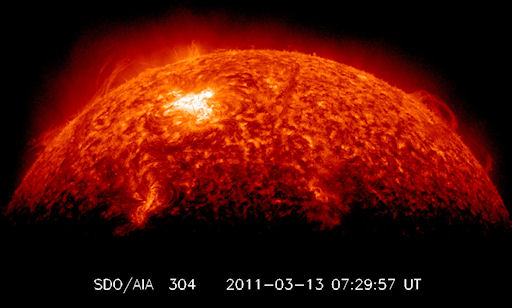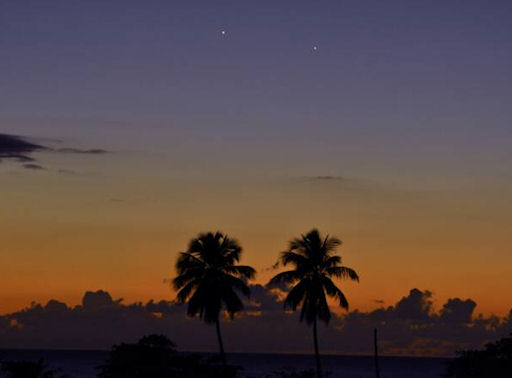Metallic photos of the sun by renowned photographer Greg Piepol bring together the best of art and science. Buy one or a whole set. They make a stellar gift. | | |
GROWING QUIET: The sun is quieting down as the last of the recent big sunspots, AR1169, rotates off the western limb. NOAA forecasters estimate a slight 1% chance of X-flares during the next 24 hours.
EQUINOX SOLAR ECLIPSE: It must be spring. This is the time of year when the sun, Earth, and NASA's Solar Dynamics Observatory in geosynchronous orbit can line up for spectacular sun-Earth eclipses. Only around equinoxes does this phenomenon occur. SDO took this picture of the sun partially blocked by our own planet on March 13th:

Every day from now until April 2, 2011, there will be a short break in the data flow as the Earth moves between SDO and the sun. The length of an eclipse can be as long as 72 minutes and they happen at about midnight at the SDO ground station in Las Cruces, NM (0700 UT). Never before has missing data looked so good.
PLANETS OF THE CARRIBEAN: If you haven't looked at the sunset this week, look! Jupiter and Mercury are beaming side-by-side through the evening twilight. Last night in Puerto Rico, amateur astronomer Eddie Irizarry took a picture which he calls Planets of the Caribbean:

"We have been treated to exquisite sunsets this week," says Irizarry. "Jupiter and Mercury looked great and grabbed the attention of even casual observers."
The evening of March 17th is a particularly good time to look, because you can watch Mercury while NASA's MESSENGER probe goes into orbit around the innermost planet--a historic first. Get the full story from Science@NASA.
more sunset shots: from Doug Zubenel of Cedar Creek near De Soto, Kansas; from Vesa Vauhkonen of Rautalampi, Finland; from Charles Beanland of Gibraltar, Europe; from Marek Nikodem of Szubin, Poland; from Adrian New of San Antonio, Texas; from Aymen Ibrahem of Alexandria, Egypt; from Dr. J. Wayne Wooten of Pensacola, Florida; from Bum-Suk Yeom of Daejeon, South Korea; from Göran Strand of Froson, Sweden; from John C McConnell of Soldierstown Aghalee N.Ireland.; from Michael J. Hutchinson of Longmont, CO; from Paul Gray of Fredericton, New Brunswick, Canada; from Rosenberg Róbert of Adony, Hungary; from Martin Gembec of Jablonec n.N., Czech Republic; from Antoine Chauveau of Helsinki, Finland; from Tamás Ábrahám of Zsámbék, Hungary; from Alfredo Garcia Jr of Lomita, CA
March 2011 Aurora Photo Gallery
[previous Marches: 2010, 2009, 2008, 2007, 2006, 2005, 2004, 2003, 2002]
Potentially Hazardous Asteroids (
PHAs) are space rocks larger than approximately 100m that can come closer to Earth than 0.05 AU. None of the known PHAs is on a collision course with our planet, although astronomers are finding
new ones all the time.
On March 16, 2011 there were 1204 potentially hazardous asteroids.
Notes: LD means "Lunar Distance." 1 LD = 384,401 km, the distance between Earth and the Moon. 1 LD also equals 0.00256 AU. MAG is the visual magnitude of the asteroid on the date of closest approach. | | The official U.S. government space weather bureau |
| | The first place to look for information about sundogs, pillars, rainbows and related phenomena. |
| | Researchers call it a "Hubble for the sun." SDO is the most advanced solar observatory ever. |
| | 3D views of the sun from NASA's Solar and Terrestrial Relations Observatory |
| | Realtime and archival images of the Sun from SOHO. |
| | from the NOAA Space Environment Center |
| | the underlying science of space weather |
| | for out-of-this-world printing and graphics |

